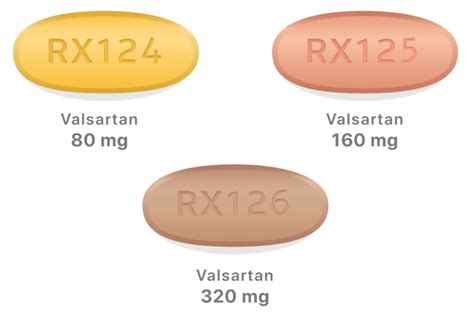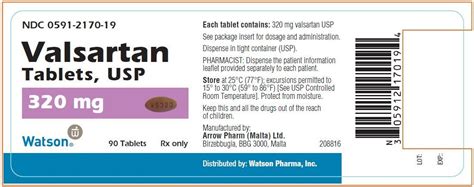Intro
Valsartan is a medication that has been widely used to treat various cardiovascular conditions, including high blood pressure and heart failure. Understanding how valsartan works is essential to appreciating its benefits and potential side effects. Valsartan belongs to a class of medications known as angiotensin II receptor blockers (ARBs), which play a crucial role in regulating blood pressure and cardiovascular function. The importance of valsartan lies in its ability to effectively manage conditions that affect millions of people worldwide, making it a vital component of modern cardiovascular therapy.
The mechanism of action of valsartan is closely related to the renin-angiotensin-aldosterone system (RAAS), a complex physiological pathway that controls blood pressure and fluid balance in the body. In this system, the hormone angiotensin II is a key player, causing blood vessels to constrict and promoting the release of aldosterone, a hormone that increases sodium retention by the kidneys. This leads to increased blood volume and pressure. Valsartan works by blocking the action of angiotensin II on its receptor, preventing the constriction of blood vessels and the release of aldosterone. This blockade results in vasodilation (widening of blood vessels) and a decrease in blood pressure, making it easier for the heart to pump blood.
The use of valsartan has been extensively studied, and its efficacy in managing hypertension and heart failure has been well-documented. By reducing blood pressure, valsartan decreases the risk of cardiovascular events such as heart attacks, strokes, and kidney disease. Its role in heart failure is equally significant, as it helps to reduce the strain on the heart, improve symptoms, and enhance survival rates. The benefits of valsartan are not limited to its direct effects on the cardiovascular system; it also has protective effects on the kidneys and can reduce the progression of kidney disease in patients with diabetes or hypertension.
Pharmacological Properties of Valsartan

The pharmacological properties of valsartan make it an attractive option for the treatment of cardiovascular diseases. It is orally active, with a high bioavailability that allows for effective absorption into the bloodstream. Valsartan is highly selective for the angiotensin II type 1 (AT1) receptor, which is responsible for the harmful effects of angiotensin II, such as vasoconstriction and aldosterone release. This selectivity minimizes the risk of unwanted side effects associated with the blockade of other receptors. Additionally, valsartan has a long duration of action, allowing for once-daily dosing, which enhances patient compliance.
Benefits of Valsartan in Hypertension Management
The benefits of valsartan in hypertension management are multifaceted. By controlling blood pressure, valsartan reduces the risk of developing complications such as heart disease, stroke, and kidney disease. Its use has been associated with a significant reduction in cardiovascular morbidity and mortality. Furthermore, valsartan is well-tolerated, with a side effect profile that is comparable to placebo in many studies. This makes it an excellent option for patients who may not tolerate other classes of antihypertensive medications.Clinical Uses of Valsartan

The clinical uses of valsartan extend beyond hypertension to include the treatment of heart failure and the reduction of cardiovascular risk in patients with left ventricular dysfunction or myocardial infarction. In heart failure, valsartan is used to reduce mortality and morbidity, improving symptoms and exercise tolerance. Its role in post-myocardial infarction patients is to reduce the risk of further cardiovascular events, such as another heart attack or the development of heart failure.
Side Effects and Interactions of Valsartan
While valsartan is generally well-tolerated, it can cause side effects, including dizziness, headache, and increased potassium levels. It is essential for patients to monitor their blood pressure and potassium levels regularly while taking valsartan. Additionally, valsartan can interact with other medications, such as diuretics, lithium, and certain antidepressants, which may require dose adjustments or close monitoring.Dosage and Administration of Valsartan

The dosage and administration of valsartan vary depending on the indication and patient factors, such as age and renal function. For hypertension, the usual dose is 80-160 mg once daily, which can be adjusted based on blood pressure response. In heart failure, the target dose is often higher, up to 320 mg daily, to maximize the benefits on survival and symptoms. It is crucial to follow the prescribed dosage and consult a healthcare provider before making any changes.
Future Perspectives on Valsartan Therapy
The future perspectives on valsartan therapy are promising, with ongoing research exploring its potential benefits in other cardiovascular conditions, such as diabetic nephropathy and atrial fibrillation. The development of combination therapies that include valsartan and other antihypertensive agents may offer enhanced blood pressure control and improved cardiovascular outcomes. Furthermore, the use of valsartan in specific populations, such as the elderly or those with chronic kidney disease, requires further investigation to optimize its benefits and minimize risks.Conclusion and Final Thoughts

In conclusion, valsartan is a valuable medication in the management of hypertension and heart failure, offering significant benefits in reducing cardiovascular risk and improving patient outcomes. Its pharmacological properties, clinical uses, and dosage considerations make it a versatile and effective treatment option. As research continues to uncover the full potential of valsartan, its role in cardiovascular therapy is likely to expand, providing new avenues for the treatment and prevention of cardiovascular diseases.
Call to Action

We invite readers to share their thoughts and experiences with valsartan therapy, either as a patient or a healthcare provider. Your insights can help others understand the benefits and challenges of this medication, contributing to a more informed and supportive community. Please feel free to comment, share this article, or explore other resources on cardiovascular health to continue the conversation.
What is the primary mechanism of action of valsartan?
+Valsartan works by blocking the action of angiotensin II on its receptor, preventing the constriction of blood vessels and the release of aldosterone, which leads to a decrease in blood pressure.
What are the common side effects of valsartan?
+Common side effects of valsartan include dizziness, headache, and increased potassium levels. It is essential to monitor blood pressure and potassium levels regularly while taking valsartan.
Can valsartan be used in patients with kidney disease?
+Yes, valsartan can be used in patients with kidney disease, but with caution. The dosage may need to be adjusted based on renal function, and patients should be closely monitored for changes in kidney function and potassium levels.
